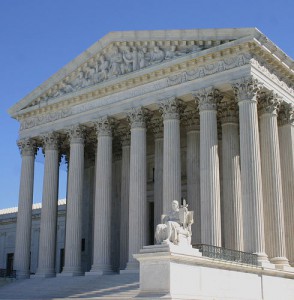Supreme Court Rules on DOMA, Prop 8 and the Voting Rights Act. What’s Next?

AHA’s Legislative Associate Matthew Bulger examines the recent U.S. Supreme Court rulings on marriage equality and voting rights. Will the battle for full equality continue?
The Supreme Court is a mysterious institution in contemporary American political society, as most Americans couldn’t really tell you what it does or even what the names are of the people who serve as justices. The large number of controversial rulings the court issued in June only added to the mystery that surrounds the court, as Americans are left wondering why the justices ruled the way they did and what the impact of these rulings will be on American society.
One of the more consequential rulings came from the court’s recent decision in Shelby County v. Holder, a case involving voting rights. Specifically, the case challenged a provision of the Voting Rights Act, the bill that resulted from the civil rights movement that banned the discriminatory voting practices which caused the widespread disenfranchisement of African-Americans.
The particular provision helped determine which states and local governments needed to get approval from the federal government before changing their voting laws. Those that had a long history of discrimination against minority voters, mainly states and localities in the South, were required by this provision to maintain voting laws and policies which extended the basic democratic right to vote free from harassment to African-Americans and other minorities.
Unfortunately, the Supreme Court effectively struck down this provision. The court determined that the formula used to decide which state and local governments require federal approval before changing their voting policies was outdated and unconstitutional. The court didn’t actually outlaw the practice of requiring state and local government that have a history of voter discrimination to have their voting policies approved by the federal government. However, by asking the notoriously gridlocked Congress to come up with a new formula to determine which governments should be regulated by this provision the court has essentially nullified the protections which help millions of Americans express their democratic right to vote.
This ruling, while very controversial, was largely overshadowed by the court’s decisions on gay marriage cases Hollingsworth v. Perry, challenging California’s Proposition 8, and Windsor v. United States, challenging the Defense of Marriage Act.
Proposition 8 has remained in the news since the moment the majority of California voters agreed that it should amend their state’s constitution to prohibit same-sex marriage. Many Californians were dismayed to see it pass, and the government of California even declined to defend the law when LGBT activists brought the issue to court. Those who were devastated when Prop 8 had passed were therefore equally excited when a federal district court and appeals court held Prop 8 to be an unconstitutional violation of the 14th Amendment.
However, proponents of Prop 8 were determined to prevent marriage equality and brought their case to the Supreme Court themselves rather than rely on the government of California to defend the proposition. While these activists were certainly dedicated to their cause, the court ruled that the sponsors of Proposition 8 did not have standing (a legal term used to determine whether a person can participate in a case) to appeal the judgment of the federal district court and the appeals court. As a result of this ruling, Prop 8 was effectively overturned in California, allowing same-sex couples to wed.
The impact of this decision was instantaneous, as it allowed LGBT Californians to marry and enjoy the state benefits that California offers to married couples. However, this ruling was written in a way that did not force other states that have same-sex marriage bans to stop enforcing their discriminatory marriage laws, nor did it afford federal marriage benefits to those LGBT Californians who could now wed.
Instead, federal marriage benefits were dealt with in Windsor v. United States, which challenged a section of the Defense of Marriage Act. The Defense of Marriage Act was passed in 1996, and the section that was challenged in this case has been effectively used since that time to prevent same-sex couples from receiving marriage benefits from the federal government, even if their state permitted same-sex marriage. The court found that this section was an unconstitutional violation of the Fifth Amendment, and subsequently struck this section down. As a result, the federal government can no longer discriminate against LGBT couples in states that allow same-sex marriage, which means that millions of couples across the country will now be treated the same as their heterosexual neighbors.
While the Supreme Court’s ruling struck down a provision of DOMA that defined marriage as a union between one man and one woman, other sections of the law still remain in effect. These sections deal with the rights of states when it comes to marriage, such as the right of a state to deny recognition of same-sex marriages that originated in other states. The court also neglected to affirm a federal right to same-sex marriage, which means that some states can continue to discriminate against their citizens based solely upon their sexual orientation.
These cases, and the multitudes that will follow, reaffirm the Supreme Court as an equally beguiling and important institution. Many of us are left to wonder why the court would strike down laws that protected the voting rights of countless Americans while granting federal and state benefits to couples that previously had been prevented from receiving them. Even more of us are wondering why the court would recognize that the government discriminating against people based on their sexual orientation is unconstitutional while still allowing state governments to keep in place discriminatory marriage laws. Hopefully, the court will recognize just how much power it holds and use that influence to protect the rights of all Americans instead of picking and choosing whose rights are worth protecting.
